The way you present your food is not just for aesthetics; it plays a crucial role in how you savor your meal. A well-arranged dish can enhance the flavors, taking your dining experience to the next level. Vibrant colors and varied textures not only catch your eye but also entice your taste buds. The selection of plates and the presentation of the food are vital in shaping your perception of flavor. Even the ambiance created by lighting and music can either enhance or detract from your meal’s enjoyment. Interested in how all these elements come together? There is a world of possibilities waiting to elevate your home cooking into a beautiful culinary experience.
Key Takeaways
- Food plating enhances meal enjoyment by creating anticipation and appreciation for flavors through visual engagement and aesthetics.
- Color choices in plating significantly impact flavor perception and emotional responses, influencing overall dining experiences.
- Effective use of lighting and ambiance can enhance flavor intensity and enjoyment, shaping how food is perceived.
- Music plays a crucial role in dining atmosphere, affecting taste perception and enhancing the overall sensory experience.
- Mindful and artistic plating techniques can transform everyday meals into extraordinary dining experiences, fostering creativity and connection.
The Art of Food Plating

When you plate food, you're not just serving a meal; you're creating an experience that can elevate the enjoyment of your dish. The art of food plating plays an essential role in how diners perceive the taste and overall quality of their meals. For instance, a beautifully plated dish like Red-Braised Pork Belly can enhance the anticipation and appreciation of its rich flavors.
Studies reveal that artistic salads can be rated up to 29% tastier than their unarranged counterparts, highlighting the powerful psychology behind aesthetics.
By utilizing contrasting colors and textures, you can create a vibrant presentation that draws attention and stimulates appetite. Incorporating negative space in your plates helps avoid clutter, allowing your food to shine as the centerpiece. Techniques like using plating rings for uniform shapes or squeeze bottles for sauces can transform your home-cooked meals into restaurant-level presentations.
The psychology of plating encourages mindful eating habits. When food looks appealing, you're more likely to savor each bite, enhancing your overall meal satisfaction.
How Plating Affects Taste
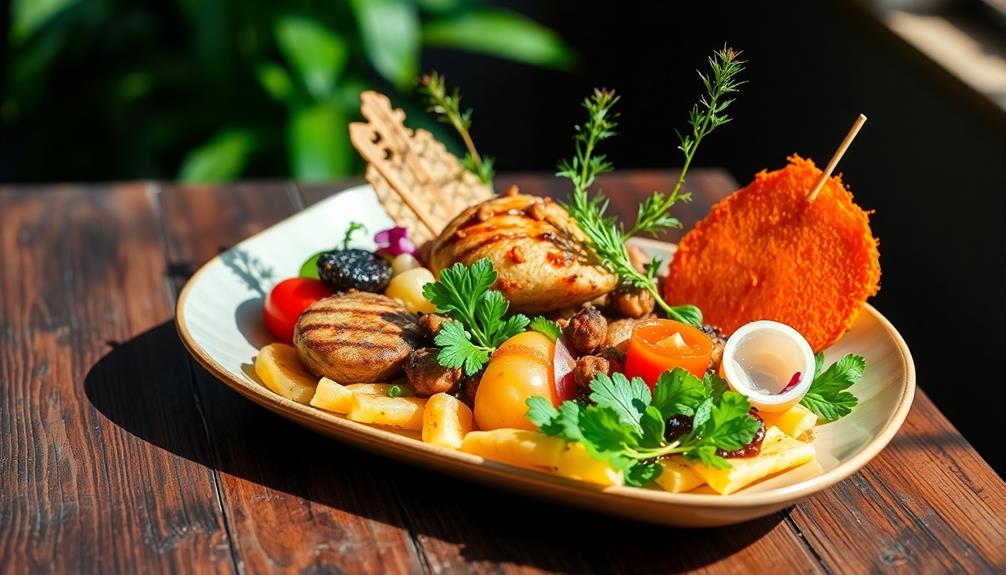
Many people don't realize just how much plating can influence their perception of taste. When you present food, you're not just serving a meal; you're engaging your diner's senses.
Research shows that visual processing engages 50% of the brain, meaning the way you plate your dish can considerably alter how it's perceived. Plating is artistic, and studies have demonstrated that beautifully arranged salads are rated 29% tastier than their less appealing counterparts.
Curiously, the rich culinary traditions from around the world, such as Asian Cuisine, can inspire unique plating styles that enhance the dining experience.
Using the right dinnerware also matters. For example, white plates tend to amplify sweet flavors, while darker, angular plates enhance savory tastes. This simple choice can change the taste experience before the first bite is taken.
Additionally, messy plating can diminish flavor perception, while a well-arranged presentation elevates the overall enjoyment of the meal.
Colors and Their Impact
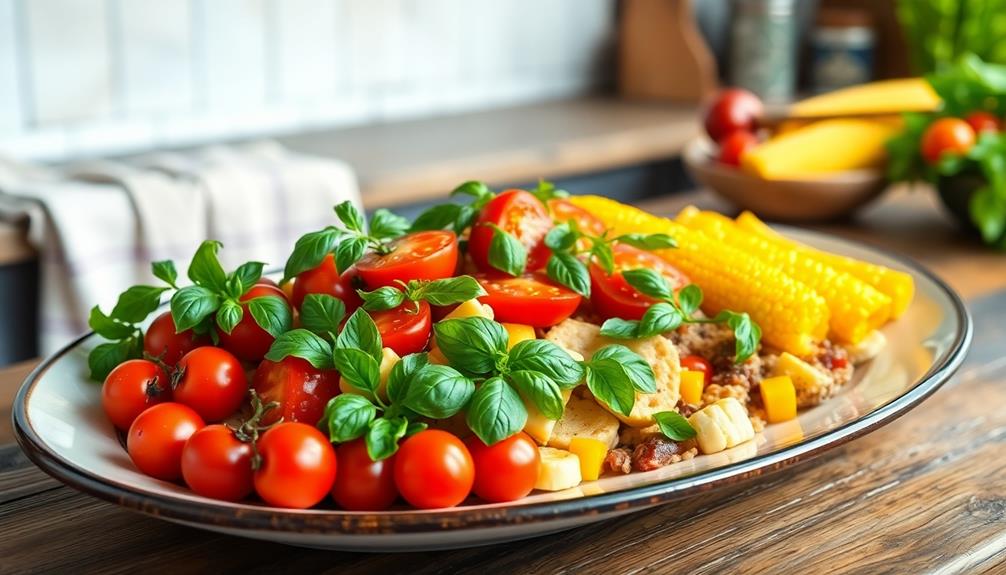
Plating goes beyond mere aesthetics; it greatly impacts how you perceive flavors, and color plays an essential role in that effect. The colors you choose can enhance your dining experience and influence flavor perception in profound ways. For instance, round, white plates can elevate sweetness, while black, angular plates amplify savory notes. Bright colors foster excitement and stimulate appetite, whereas dull hues might detract from enjoyment.
Here's a quick guide to how different colors may affect your dining experience:
| Color | Impact on Flavor Perception | Emotional Response |
|---|---|---|
| Red | Enhances warmth and appetite | Passion, excitement |
| Green | Evokes associations with veggies | Freshness, healthiness |
| Yellow | Stimulates excitement | Happiness, energy |
When you use colors consciously, you not only make your dishes visually appealing but also shape the emotions and expectations tied to your meal. For example, serving desserts on green plates might subconsciously signal that they're less appealing. By considering colors in your plating, you can greatly elevate the overall dining experience.
Lighting and Ambiance
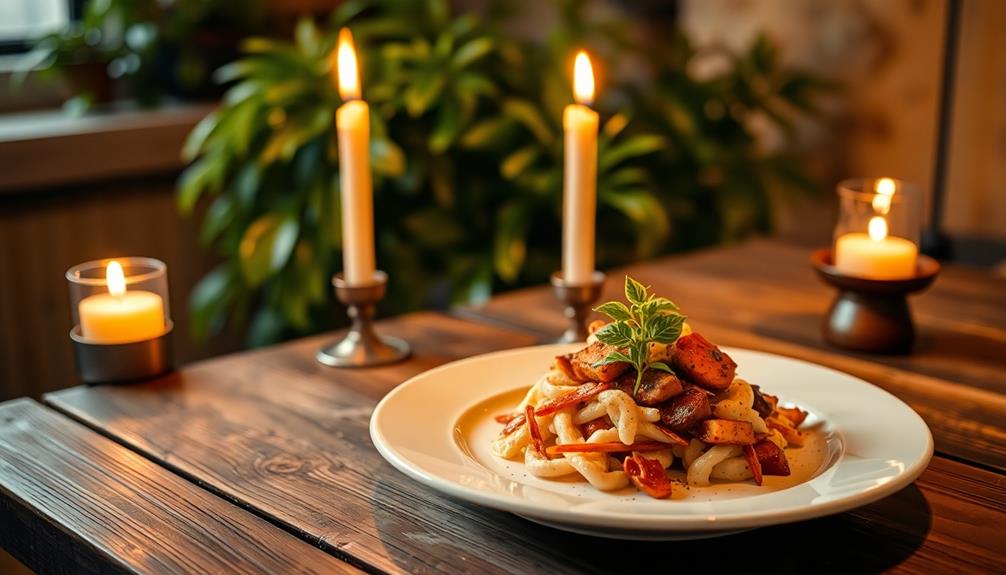
When you consider the lighting in your dining space, think about how it shapes your perception of food.
Bright lights can amplify bold flavors, while softer tones enhance delicate dishes.
For instance, the vibrant colors of a dish like Caldeirada can be further accentuated under warm lighting, creating a mouthwatering visual appeal.
The right ambiance not only invites guests in but also plays an essential role in their overall enjoyment of the meal.
Lighting Effects on Perception
Lighting dramatically shapes how you perceive food, impacting everything from flavor intensity to overall enjoyment. The right lighting can enhance your dining experience or detract from it.
For example, when serving dishes like Nettle and Potato Soup, bright lighting can help highlight the vibrant green color, making the dish appear more appetizing.
Here are some key lighting effects to evaluate:
- Bright lighting: Boosts the perception of strong flavors, making it perfect for rich dishes.
- Dim light: Creates a cozy ambiance, enhancing subtle flavors in lighter meals.
- Colored lighting: Affects food perception; red lighting can amplify the fruitiness in wines, while blue lighting might reduce your appetite.
- Consistent lighting: Helps maintain a cohesive dining experience, while abrupt changes can distract and alter your perception of the food.
- Warm vs. cool lighting: Influences the mood; warm light can create a welcoming environment, enhancing overall enjoyment.
Color Temperature Impact
The temperature of color in your dining space can dramatically influence your meal experience. Bright light, for instance, enhances strong flavors and encourages you to enjoy your food more. This type of lighting sets the stage for vibrant meals, such as a beautifully plated Dorayaki (Red Bean Pancake), making them appear more appealing.
On the other hand, dim lighting creates a cozy atmosphere, perfect for savoring subtle flavors while allowing you to relax.
Think about how colored lighting can affect your dining experience. Red lighting might amplify the fruitiness of wine, making it taste even better. Conversely, blue lighting could reduce your food intake by altering your visual expectations and appetite.
The overall ambiance you create with color temperature plays a vital role in how enjoyable your meal is. Warmer lights often make food look more appetizing, enhancing your overall dining experience.
Creating Inviting Atmosphere
An inviting atmosphere transforms an ordinary meal into an extraordinary experience. The right lighting and ambiance not only enhance the aesthetics of your dish but also greatly boost your overall enjoyment.
For instance, when hosting Halloween-themed gatherings, consider serving dishes like Graveyard Taco Dip that not only taste great but also create a visual impact.
Here's how you can create that perfect setting:
- Adjust the lighting: Use dim lighting for subtle flavors and brighter lights for bold tastes.
- Incorporate colored lights: Consider red tones to amplify fruitiness or blue to subtly reduce portions.
- Arrange your space: Guarantee comfort in your dining area, as this influences your meal's enjoyment.
- Control the temperature: A comfortable room temperature is essential for a pleasurable dining experience.
- Maintain consistency: Cohesive lighting and decor elevate the sensory experience, making your meal feel special.
Music's Role in Dining

You mightn't realize it, but the music playing while you eat can greatly enhance your dining experience.
Pairing your meal, such as a rich Mushroom Masala, with carefully chosen melodies can create a harmonious atmosphere that complements the flavors.
Different sound frequencies can amplify the flavors you're tasting, making sweet dishes even sweeter and savory ones more satisfying.
Music Enhances Flavor Perception
Music's powerful influence on flavor perception can transform an ordinary meal into a multisensory experience. When you pair your meals with the right tunes, you can elevate the enjoyment of sweet foods and savory dishes alike.
Higher-pitched sounds, like chimes, boost the perceived sweetness of your favorite desserts, while lower-pitched music enhances savoriness in savory meals. This interplay can completely change how you experience your food, making dishes like Turkey Soup even more comforting and enjoyable.
Here are some ways music can enhance your dining experience:
- Higher frequencies can make sweet foods taste even better.
- Classical music can enhance wine enjoyment during tastings.
- Faster tempos can speed up your eating, altering flavor perception.
- Rhythm and tempo influence how you savor your meal.
- Emotional responses to music can amplify sensory experiences.
Sound Frequencies and Taste
Sound frequencies play an essential role in shaping our taste experiences, influencing how we perceive flavors during meals. Research shows that higher-pitched sounds enhance sweet flavors, making desserts and fruits even more enjoyable. For instance, the delicate sweetness of a dessert like Agnolotti can be elevated by the right soundscape.
So, the next time you indulge in a sweet treat, consider the soundtrack playing in the background; it could heighten your enjoyment.
On the flip side, savory foods benefit from lower-pitched sounds. When you savor a rich stew or a hearty pasta dish, the deep tones can elevate your dining experience, making those flavors more pronounced. This connection between sound and taste is a powerful tool in both home and restaurant settings.
Studies have even found that classical music can enhance your appreciation of wine, demonstrating how the right sound frequencies can transform a simple meal into a culinary delight.
Many restaurants curate playlists to align with specific food types, ensuring that sound complements flavor. By understanding the influence of sound frequencies on taste, you can enhance your own dining experiences at home, creating an atmosphere that elevates both sweet and savory dishes alike.
Creating Ambiance With Music
An inviting atmosphere can transform a meal into a memorable experience, and the right music plays a pivotal role in achieving that ambiance. The psychological effects of music can greatly influence your dining experience, shaping your mood and altering your perception of flavors.
For instance, serving a rustic dish like Horiatiko Psomi alongside your meal can enhance the overall sensory experience. Here are some ways to enhance your meal with music:
- Choose Higher-Pitched Sounds: These can enhance sweetness in dishes.
- Opt for Lower-Pitched Tunes: They complement savory flavors beautifully.
- Experiment with Genres: Different styles can elevate the overall dining experience.
- Incorporate Classical Music: This can enhance wine enjoyment and food pairings.
- Create a Cohesive Playlist: Thoughtful selections reinforce the sensory experience.
Creating a Multi-Sensory Experience
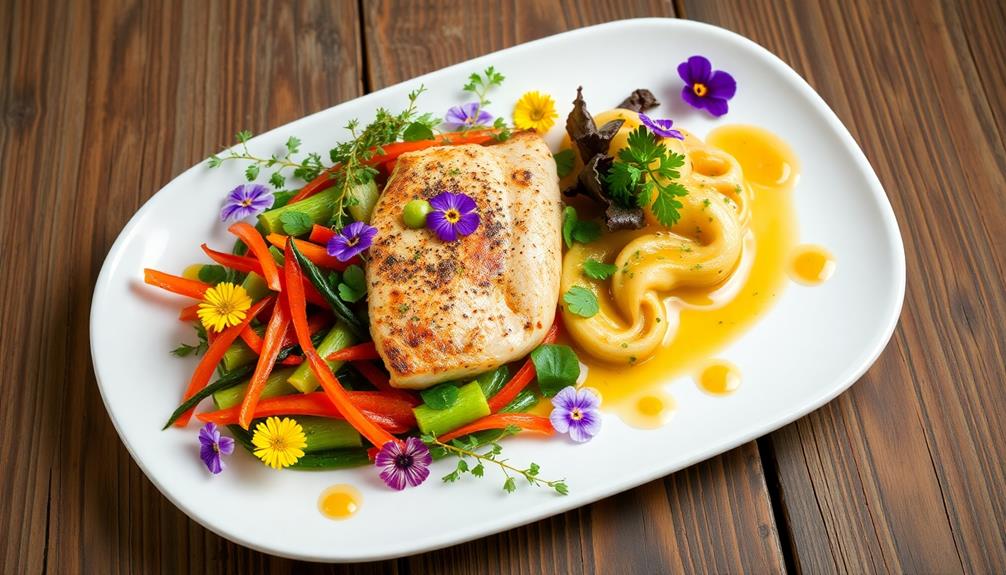
When you plate a dish, you're not just serving food; you're setting the stage for a multi-sensory experience that can transform a meal into a memorable event. The visual appeal of your presentation plays a significant role in how diners perceive and enjoy their meal.
Studies show that beautifully plated food can evoke positive emotions and justify higher pricing, making aesthetic presentation essential.
To enhance the experience, incorporate a variety of colors, textures, and garnishes. This not only adds visual interest but also engages multiple senses, making each bite more exciting. For example, artistic salads are rated 29% tastier than their less appealing counterparts, highlighting the power of a well-plated dish.
Additionally, strategic use of negative space prevents clutter, allowing each component to shine. When you create height and layering in your presentation, you captivate diners and elevate their overall experience.
Techniques for Effective Plating
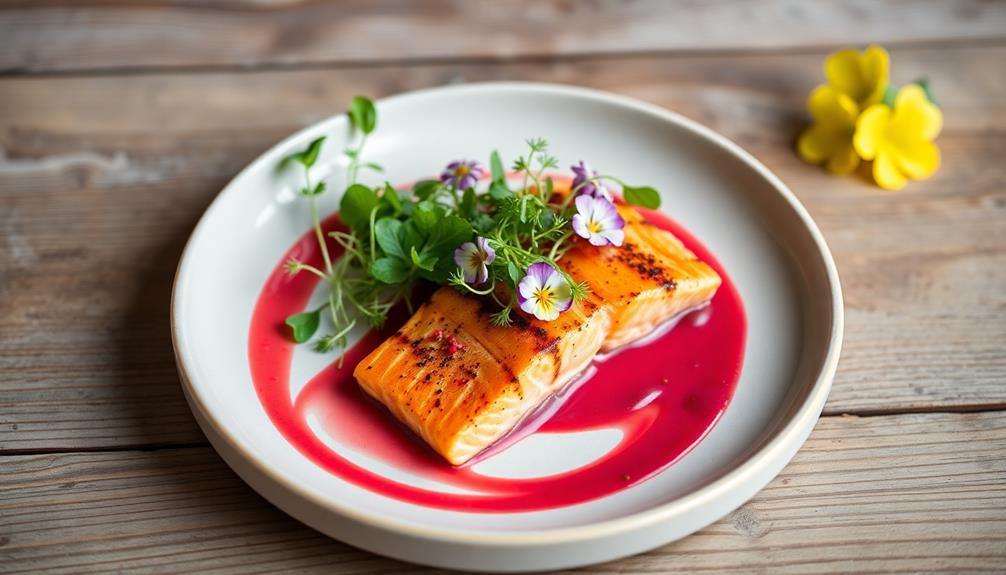
Effective plating techniques can elevate your dishes from ordinary to extraordinary, transforming how diners perceive their meals. By thoughtfully arranging your food, you can enhance both visual appeal and overall enjoyment.
Here are some essential techniques to take into account:
- Plan and Organize: Choose contrasting colors and arrange components for a vibrant presentation.
- Experiment with Textures: Layer ingredients and create height to add visual interest and balance.
- Incorporate Garnishes: Use fresh herbs or edible flowers to enhance textures and colors while utilizing negative space to avoid clutter.
- Choose Appropriate Dinnerware: Opt for round, white plates for sweet dishes or angular black plates for savory flavors to optimize visual appeal.
- Employ Plating Tools: Use plating rings for uniform shapes, squeeze bottles for sauces, and tweezers for delicate garnishes to achieve precision.
Storytelling Through Presentation
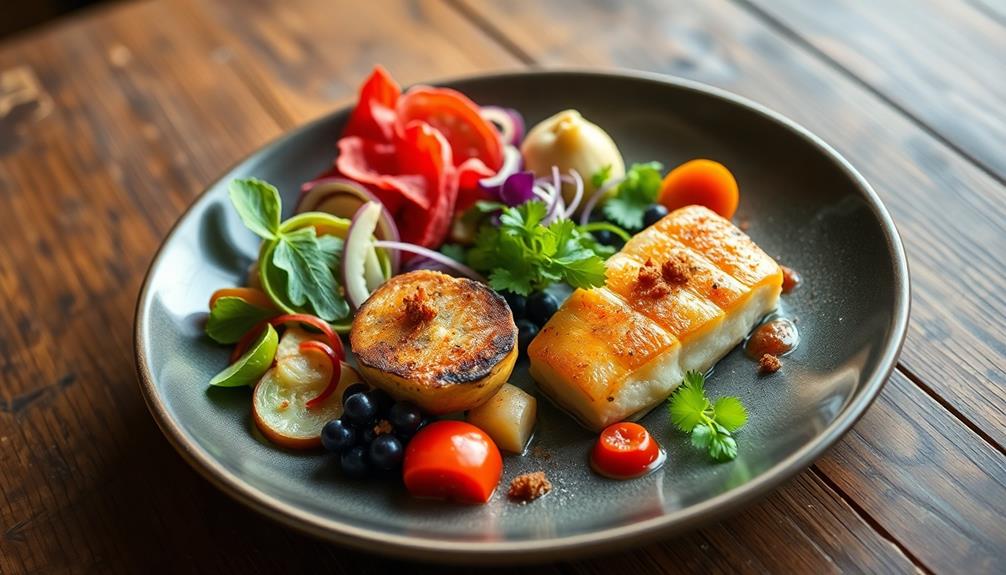
Storytelling through presentation transforms a meal into an experience, allowing chefs to express their creativity and connect with diners on a deeper level. When you plate a dish, you're not just arranging food; you're crafting a narrative. Each ingredient selection and artistic element can evoke emotions and memories, creating an emotional connection that elevates the dining experience.
Research shows that 18% of diners prefer artistic presentation, highlighting how powerful storytelling can be in enhancing customer satisfaction and perceived value. By using seasonal ingredients, for example, you tell the story of the time of year, linking diners to the freshness and origin of their meal.
A beautiful plate not only creates anticipation but also justifies higher pricing, making the meal memorable long after it's finished. Engaging presentation styles, like incorporating whimsical elements or cultural significance, can turn a simple meal into an enchanting storytelling experience that delights diners.
Ultimately, effective food presentation isn't just about aesthetics; it's a chance to share stories, evoke emotions, and forge connections, making every meal a unique narrative that resonates with those who enjoy it.
Enhancing Meals With Atmosphere

The right atmosphere can transform a good meal into an unforgettable experience. When you focus on elements like lighting, color, and sound, you greatly enhance your dining experience.
Here are some tips to create the perfect atmosphere:
- Adjust your lighting: Use bright lighting for bold flavors and softer lighting for subtle tastes.
- Incorporate color psychology: Warm colors can create a welcoming vibe, while cool colors can evoke calmness.
- Choose the right music: Higher-pitched sounds can elevate the perception of sweetness in desserts, adding an auditory layer to your meal.
- Create a cohesive theme: Align your decor, lighting, and music to engage multiple senses consistently.
- Foster positive interactions: Humor and engaging conversations can enhance flavor perception and overall satisfaction.
The Future of Home Dining

As you explore the future of home dining, consider how innovative presentation techniques can transform your meals.
By focusing on artistic plating, you not only enhance the visual appeal but also elevate the entire dining atmosphere.
With the right approach, even a simple meal can feel like a special occasion right at your table.
Innovative Presentation Techniques
While many home cooks focus on flavor, innovative presentation techniques can transform a simple meal into a memorable dining experience. By mastering a few plating techniques, you can enhance the visual appeal of your dishes and encourage mindful eating. Here are some ideas to elevate your home dining:
- Use plating rings to create uniform shapes.
- Experiment with contrasting colors and textures.
- Incorporate height by layering or stacking elements.
- Utilize negative space to avoid clutter.
- Add garnishes for a pop of color and sophistication.
These methods not only make your food look more attractive but also promote a sense of enjoyment and satisfaction during meals.
When you take the time to present your food beautifully, you create a more engaging dining experience that invites appreciation and attention.
Plus, you'll find inspiration in online courses and social media platforms, offering a wealth of resources to refine your skills.
Enhancing Dining Atmosphere
Creating an enchanting dining atmosphere at home can transform an ordinary meal into an extraordinary experience. To achieve this, pay attention to the details that elevate your food and drink presentation.
Start with lighting; bright lights can highlight strong flavors, while soft, dim lighting enhances subtler tastes. Experiment with different lighting options to set the right mood for each meal.
Next, don't underestimate the power of music. Curate playlists that align with your dishes—higher-pitched sounds pair beautifully with sweet foods, while savory dishes thrive on lower-pitched tunes. This thoughtful integration of music can greatly enhance your dining atmosphere.
Lastly, focus on your table setting. Use clean, aesthetically pleasing dinnerware and arrange your food thoughtfully. Engaging in DIY meal preparation and plating not only hones your cooking skills but also makes your meals visually appealing.
When you create an inviting atmosphere with the right lighting, music, and presentation, you turn a simple dinner into a memorable dining experience. Embrace these elements, and watch how your home dining transforms into something truly special.
Frequently Asked Questions
What Is the Psychology of Plates?
The psychology of plates shapes your dining experience. Colors and shapes influence your perception of flavor, making meals more appealing. When you plate food thoughtfully, you enhance enjoyment, encourage consumption, and even affect your mood.
What Is the Nordic Look Technique Plating?
Did you know that 70% of diners judge a meal by its presentation? The Nordic Look technique emphasizes simplicity and natural ingredients, using negative space and earthy tones to highlight freshness and promote visual harmony on your plate.
How Plating Affects One's Perception on Food?
Plating affects your perception of food by influencing how you feel about its taste and quality. When dishes are visually appealing, you're likely to enjoy them more, enhancing your overall dining experience and satisfaction.
What Is the Purpose of Plating in Cooking?
The purpose of plating in cooking is to make your dish visually appealing. When you present food beautifully, it enhances its perceived taste, making your dining experience more enjoyable and inviting for everyone at the table.
Conclusion
In the end, remember that you eat with your eyes first. By focusing on the art of food plating, you can elevate your home dining experience and make every meal feel special. Consider how colors, lighting, and even music can enhance the overall atmosphere. With a few techniques, you can turn simple dishes into culinary masterpieces that tell a story. Embrace the psychology of plating, and you'll find that every meal becomes a celebration.








